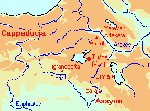|

|
|

|
|
|
||||||||||||||||
 |
Urartu (Akkadian
Uraštu; Hebrew
Ararat): ancient kingdom, situated along the river Araxes (modern
Aras), the Upper
Tigris
and the Upper
Euphrates.
The original name of Urartu was Biainele; its capital the rock fortress Tušpa (modern Van). The country may be envisaged as a big rectangle, with Lake Van ("Thospitis") as its southwestern, Lake Urmia ("Matianus") as its southeastern, Lake Sevan ("Lichnitis") as its northeastern and Lake Çildir as its northwestern corner. In its center was the mountain Massis. This impressive summit was in the Middle Ages called after the kingdom: the Ararat, so well-known from the biblical story about Noah (Genesis 8.4) and the Flood. |
|||||||||||||||
|
Ararat, seen from the northwest. |
The people of Urartu, famous metalworkers,
spoke a language that was related to Hurrian (a language that has no
other known connections), and they adapted the
Assyrian cuneiform script for their own
purposes. Most inscriptions -although there are not many- can be read:
nearly all of them refer to royal construction activity. For a
reconstruction of Urartian history we depend on Assyrian sources. It appears that from the ninth century on, Urartu was ruled by a single dynasty, which expanded thre kingdom to the south in a period when Assyria was weak. The Euphrates became Urartu's western border. However, Assyria recuperated and in 714 BCE, the Armenian king Rusa was defeated by the Assyrian king Sargon, who marched almost unopposed through the country and took possession of the statue of the Urartian supreme god Haldi. (The event is recorded in the Assyrian Eponym List.) After this humiliation, Rusa refused to live and committed suicide. |
|
||||||||||||||
|
|
|||||||||||||||
|
|
||||||||||||||||
|
|
||||||||||||||||
|
Among the Urartian sites are:
|
||||||||||||||||
Literature
|
© Jona Lendering for Livius.Org, 1998 Revision: 19 October 2007 |
